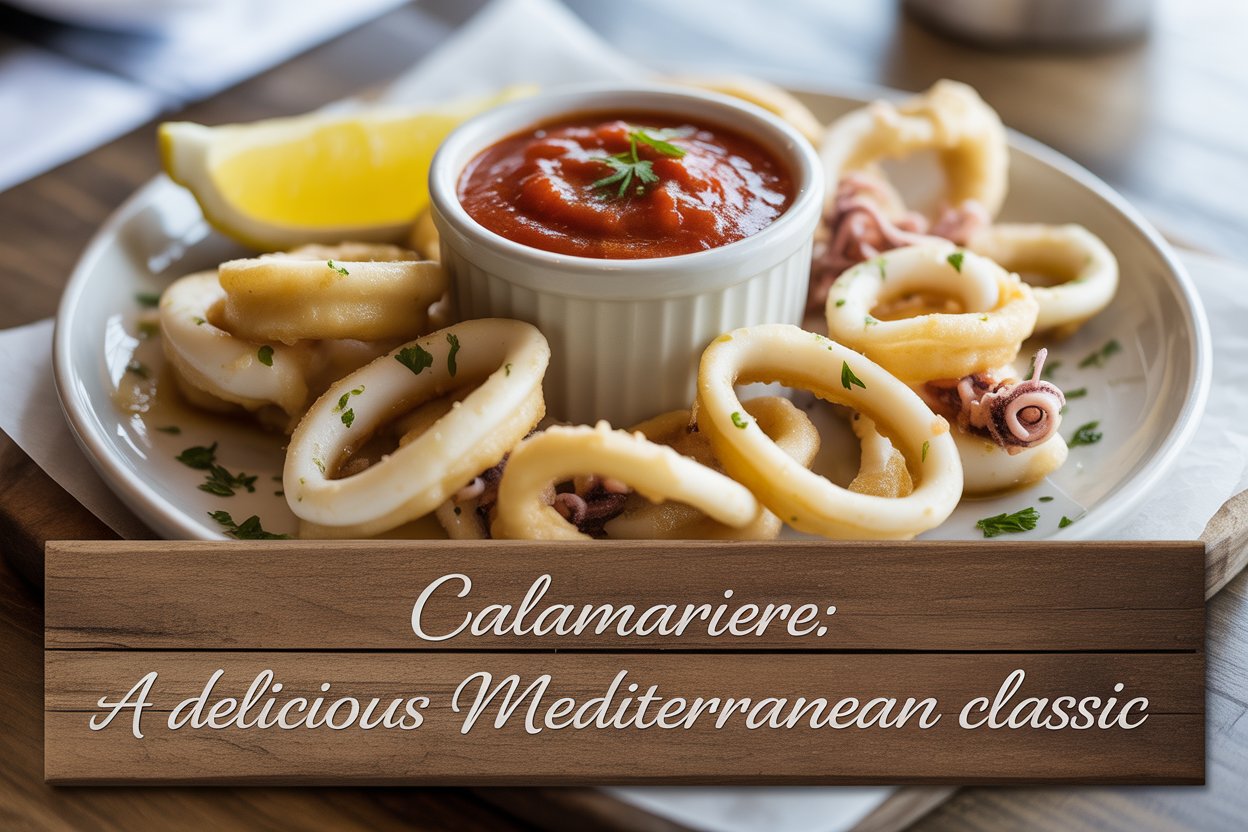Introduction : Why Calamariere Captivates Food Lovers
Calamariere is a beloved Mediterranean seafood classic that delights taste buds everywhere. Its tender, flavorful squid offers a perfect balance of crispiness and softness. Traditionally enjoyed along the sun-kissed coasts of Italy, Greece, and Spain, it carries centuries of culinary heritage.
Today, calamariere has gained global popularity, appearing on menus from bustling city bistros to seaside restaurants. Each bite reflects cultural traditions and regional flavors, connecting people to coastal life and family rituals. Beyond taste, it symbolizes craftsmanship, patience, and celebration.
For food lovers, calamariere promises a memorable dining experience. Its simple ingredients transform into a dish full of flavor and texture. Whether fried, grilled, or sautéed, calamariere,s captures the essence of Mediterranean cuisine and continues to inspire chefs and home cooks alike.
Origins and History of Calamariere
Calamariere traces its roots to the Mediterranean, especially Italy, Greece, and Spain. Coastal communities relied on fresh seafood for daily meals. Squid was abundant, affordable, and easy to prepare. Over time, families developed special techniques to clean and cook it perfectly.
In Italy, calamariere became a symbol of family tradition. Elders taught younger generations the art of handling squid with care. Greek and Spanish communities also embraced it, creating regional recipes that highlighted local flavors. Each coastal town added its unique touch.
Originally a humble dish for fishing families, cala mariere gradually gained popularity beyond the Mediterranean. Immigrants carried it worldwide, introducing new cultures to its delicious taste. Today, it is celebrated globally, appearing in street food stalls, restaurants, and gourmet kitchens alike.
Its journey shows how simple ingredients can evolve into a beloved culinary treasure.
What Makes Calamariere Special
Calamariere is more than just fried squid; it is a culinary art. The preparation involves cleaning, slicing, and lightly coating the squid. When cooked correctly, the exterior becomes golden and crispy. Meanwhile, the inside remains tender and flavorful.
Its texture is a perfect contrast: crunchy outside, soft inside. The flavor is mild yet savory, often enhanced with simple seasonings like lemon, olive oil, and herbs. This balance allows the natural taste of squid to shine.
Calamariere also symbolizes tradition and conviviality. Preparing it is considered a skill, passed down through families. Serving it fosters shared meals, celebrations, and connection. Each plate reflects patience, craftsmanship, and love for Mediterranean cuisine.
This combination of taste, texture, and cultural significance makes calamariere a timeless and cherished dish.
How to Choose and Prepare Squid for Calamariere
Choosing fresh squid is essential for perfect calamariere. Look for firm, white flesh and clear eyes. Avoid squid with a strong, unpleasant odor. If using frozen squid, thaw it slowly in the refrigerator.
Cleaning squid properly ensures tender results. Remove the head, innards, and cartilage carefully. Peel off the thin skin and rinse under cold water. Pat dry with paper towels to remove excess moisture. This prevents soggy or greasy calamari.
The right tools make preparation easier. Use a sharp knife, kitchen scissors, and a cutting board. A bowl for coating and a pan or deep fryer are also necessary. Optional tools like a thermometer help maintain the perfect frying temperature.
Following these steps guarantees squid that is ready for crisp, flavorful calamariere every time.
Cooking Techniques for Perfect Calamariere
Frying is the most popular method for calamariere. Heat oil to around 175°C (350°F) for best results. Coat the squid lightly in flour or breadcrumbs. Fry in small batches to avoid overcrowding the pan. Cook for only 60–90 seconds to keep it tender.
Grilling offers a smoky flavor and a lighter option. Brush squid with olive oil, garlic, and herbs. Cook over medium-high heat for a few minutes per side. Sautéing in butter or olive oil also works well. Add aromatics like garlic or parsley for extra flavor.
The key to perfect calamariere is quick cooking. Overcooking makes squid tough and rubbery. Always monitor heat and timing carefully. Serve immediately to enjoy the crisp exterior and tender inside.
With these techniques, every cala mariere turns out flavorful and irresistible.
Calamariere Recipes and Variations
The classic Italian calamariere is simple yet flavorful. Fresh squid is tossed with olive oil, lemon, and herbs. This version highlights the natural taste of the seafood. It is usually fried or sautéed quickly for a tender texture.
Regional Mediterranean variations offer exciting twists. In Sicily, calamariere may include capers, olives, and citrus zest. Ligurian recipes often use fresh herbs or a light pesto sauce. In Spain, fried calamari appears as tapas with garlic, parsley, and dipping sauces. Each region showcases local flavors while keeping squid the star.
Modern adaptations bring calamariere into contemporary kitchens. Grilled Asian-style squid with soy or miso glazes is popular at street food stalls. Adding calamariere to salads or pasta creates light, flavorful meals. Creative chefs also pair it with spices, citrus, or fresh vegetables for variety.
These recipes show how calamariere can be enjoyed in endless, delicious ways.
Pairing Calamariere with Sides and Drinks
Calamariere pairs beautifully with simple, flavorful sauces. Marinara, garlic aioli, and yogurt-based dips complement its taste. Each sauce adds a different layer of flavor and texture.
For sides, choose fresh and light options. Mixed greens, couscous, or baked vegetables balance the richness of fried or sautéed squid. Citrus segments or fresh herbs brighten the plate and enhance flavors.
Wine and beverages elevate the dining experience further. Crisp white wines, like Pinot Grigio or Sauvignon Blanc, cut through the richness. Light rosé or sparkling Prosecco also pairs beautifully. For casual meals, light beer or sparkling lemonade works perfectly.
Thoughtful pairings turn calamariere into a complete, memorable meal. They highlight its flavors while creating a balanced and enjoyable dining experience.
Health Benefits and Nutritional Value
Calamariere is a high-protein, low-fat seafood option. It supports muscle repair and keeps you full longer. Squid is rich in essential vitamins like B12, which aids energy and brain health.
It also contains minerals such as selenium and zinc, which boost immunity and overall well-being. Additionally, omega-3 fatty acids in squid promote heart health and reduce inflammation. These nutrients make cala mariere both delicious and nutritious.
For healthier meals, consider baking or air-frying instead of deep-frying. Light seasoning with herbs and lemon reduces extra calories. Pairing it with vegetables or salads further enhances its nutritional value.
Enjoying calamariere can be both satisfying and good for your body, making it a wholesome Mediterranean seafood choice.
Calamariere Around the World
Calamariere has traveled far beyond the Mediterranean, inspiring global adaptations. Chefs experiment with spices, sauces, and cooking techniques. Each culture adds its own twist while preserving the dish’s essence.
Street food versions are popular in many countries. Crispy fried squid served with dipping sauces is easy to enjoy on the go. Meanwhile, gourmet restaurants elevate calamariere with sophisticated presentations and creative flavor pairings. Both styles highlight its versatility.
Tradition blends seamlessly with modern innovation. Classic Mediterranean recipes meet contemporary cooking methods and global ingredients. Grilled Asian-style squid, Mediterranean pasta dishes, and fusion salads all celebrate calamariere in unique ways.
This worldwide appeal shows how a simple seafood dish can unite cultures through flavor, creativity, and culinary heritage.
Tips for Home Cooks to Master Calamariere
To master calamariere at home, avoid common mistakes. Do not overcook squid, or it becomes rubbery. Avoid overcrowding the pan, which lowers oil temperature and affects crispiness. Always pat squid dry to prevent soggy results.
Start with fresh or properly thawed squid. Clean it thoroughly, removing innards, cartilage, and skin. Lightly coat in flour or breadcrumbs for the perfect crispy texture. Heat oil or pan to the right temperature before cooking.
Step-by-step guidance helps beginners succeed. Fry or sauté in small batches for 60–90 seconds. Add seasoning or herbs after cooking to enhance flavor. Serve immediately for the best texture.
Presentation matters. Use fresh lemon wedges, chopped parsley, or a simple drizzle of sauce. Arrange calamariere on a colorful plate or wooden board. These small touches impress guests and make every meal feel special.
Conclusion: Why Calamariere Remains a Timeless Seafood Classic
Calamariere is a versatile dish, loved for its texture, flavor, and simplicity. It combines tradition with innovation, making it suitable for both classic and modern recipes. Its crisp exterior and tender interior delight food lovers worldwide.
This seafood favorite invites home cooks to explore Mediterranean flavors. With fresh ingredients and simple techniques, anyone can create restaurant-quality calamariere at home. Cooking it yourself also allows for creative twists and personalized seasonings.
Beyond taste, cala mariere carries cultural and culinary significance. It connects people to Mediterranean heritage, family traditions, and coastal celebrations. Each bite tells a story of skill, patience, and love for food.
Ultimately, calamariere remains timeless because it balances flavor, tradition, and adaptability. It is a dish that continues to inspire chefs, home cooks, and seafood enthusiasts everywhere.

